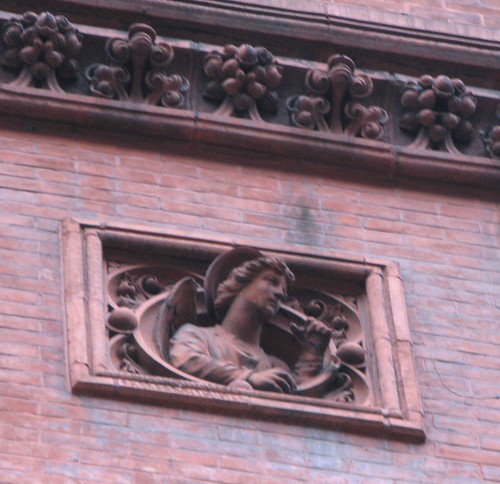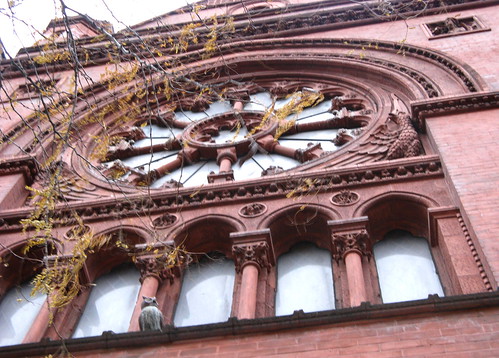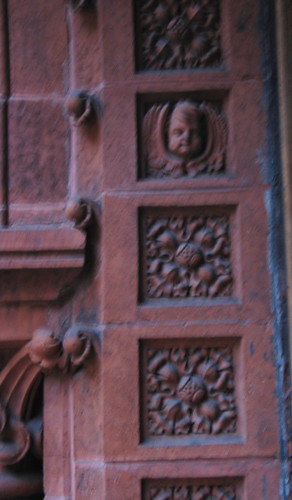An angel, calm and serene, is playing an instrument, perhaps heralding an arrival. Indeed, those worshiping inside the church where the angel is on the front exterior wall were awaiting a coming – the Second Coming of Jesus Christ. They believed it was going to happen imminently. The years of the 19th century came and went, however, without this event occurring. The denomination declined and finally gave up this church. Somehow a beautiful church building, on New York’s West 57th Street, survived.
Today, the red brick church at 417-419 West 57th St. in Manhattan – a New York City landmark – is host to another church of a different denomination. But the structure, especially its rich terra cotta decoration, tells the story of a branch of Christianity that first blossomed in America in the days of religious revival in the mid-19th century, looked for its inspiration to the early Christians, and ultimately waned in the 20th century.
In its buildings, in the design, details, and other architectural expressions, humankind expresses its values and beliefs. So it is with the Catholic Apostolic Church, which was home to a New York congregation of a religious group first established in Europe in the early 19th century. Looking at the church building today, we can be mindful of the denomination’s beliefs and even of the “booms and busts” that oftentimes afflict seemingly otherworldly entities.
Born of Prophecies
The Catholic Apostolic Church was a Christian pentecostal sect and had no link to the Roman Catholic Church. The church had its roots in Scotland and England, where a group of wealthy men began a study of prophetic Scriptures in the 1820s. Around that time, a family near Glasgow reported being able to speak in supernatural utterances. Others made similar claims. The utterances predicted that Jesus Christ’s Second Coming was near.
Accepting these particular prophecies as coming from God and true, the group of men believed that Christians must prepare for the coming, especially by reviving the customs and ways of the early Christian Church. The group designated 12 Apostles, who were to go forth as missionaries to all parts of Christendom and urge unity to prepare for the Second Coming. The Apostles established a vast hierarchy of bishops, priests, and deacons, and the church drew converts in Europe, Australia, the United States, and Canada.
In 1851, Catholic Apostolic adherents established a congregation in New York City. They met at a building the group had bought on West 16th Street. By the 1880s, the membership had grown sufficiently to need a new place of worship. In 1885, the congregation purchased two lots on West 57th Street to build a new church and hired architect Francis H. Kimball, according to a July 7, 1996 New York Times article on the building. The church completed its new home in 1885-1886.
Located midblock on the north side of West 57th Street between Eighth and Ninth avenues, the former Catholic Apostolic Church doesn’t immediately call attention to itself on a nondescript block of small apartment buildings and stores. But once you stop and look at it, you see that it’s as expressive as it is beautiful, and why so many have appreciated its exquisite materials, color, and proportion. Built on a brownstone base, the exterior of the deep-red brick church features heavenly beings fashioned in terra cotta, many with peaceful expressions that seem to go beyond the temporal world of a Manhattan street.
Kimball designed the church in the Victorian Gothic style, which originated in England and was prevalent in the second half of the 19th century. The style is characterized by pointed windows and arches, quatrefoil patterns, leaded glass, and other forms and features of medieval architecture as well as by bold color and contrast.
The large, intricate central rose window, contained within a pointed-arched frame, catches the eyes first. It’s as impressive as any found in the large Gothic cathedrals. At the time of the church’s construction, it was one of the most complex elements attempted in terra cotta, according to the 2001 designation report of the New York City Landmarks Preservation Commission (LPC).
The church is one of several buildings around West 57th and 58th streets in Midtown Manhattan that are a delight for lovers of terra cotta. (See also “Terra Cotta Tales: Alwyn Court” and “Terra Cotta Tales: The Rodin Studios” on Mindfulwalker.com.)
The Work of Two “Fathers”
Today we talk of star architects and builders, and this church certainly drew a couple of stars to work on it. It was one of the earliest independent architectural commissions for Kimball, who later became known as the “father of the skyscraper.” In addition, the leading East Coast terra cotta company at the time, the Boston Terra Cotta Co., created the church’s extensive ornamentation in that material. The company’s superintendent, James Taylor, was called “the father of American terra cotta.” Here, we can look at something like the gorgeous central rose window – especially its amazingly intricate pattern – and meditate on the effort and genius of Kimball and Taylor.
In fact, Taylor left a particular lasting “mark” on the church’s construction: The combed texture of the terra cotta is a “signature” of his participation in the building, the LPC record reveals. Taylor took this signature texture to his next company, the New York Architectural Terra Cotta Co., where the headquarters building has a similar effect. The two also collaborated on this fabled building in Queens.
Apostles and Angels were central members of the Catholic Apostolic Church’s leadership, and their titles and roles personify the church’s adherence to the ways of the early Christian Church. Apostles were the ultimate representatives of the Divine and the authorities on prophetic utterances, and they or their delegates ordained the other ministers. The ministry was exclusively male. The church’s bishops were called “Angels,” in the sense of the old word used in the Book of Revelation for bishops.
So, too, Apostles of the early Church and Angels figure prominently in the terra cotta decoration. Just below the rose window are figures of a winged lion and an eagle representing the Apostles Mark and John, respectively. (These were inspired, the LPC notes, by a similar rose window and surrounding “Four Evangelistic Beasts” sculptures carved in St. Fin Barre’s Cathedral in Cork, Ireland.) The feathers of the eagle are so prominent and large, one can almost feel them.
The church contains the figures of Angels in various places. For one, they are on the welcoming entrances of the two wings. Within the panels on each side of the arched doorways are terra cotta blocks with small cherubs and floral designs. If the Second Coming held uncertain prospects, surely the calm, sweet expressions on these cherubs could inspire feelings of security.
Decline and Rebirth
Little was spared in the church design and the terra cotta decoration in so many shapes, such as leaves, floral capitals on the columns, and miniature arches. Architectural critics and publications at the time were impressed not only with the symmetry, beauty, and fine details, but with the architect’s ability to accomplish this at minimal cost. The LPC designation cites an 1899 Brickbuilder article noting, “though one of the least pretentious, [the Catholic Apostolic Church] is considered one of [Francis Kimball’s] happiest efforts.”
The 20th century brought times that weren’t so flush for the Catholic Apostolic Church. Henry Ogden DuBois, the last Angel leading the New York Church who was also an Episcopal priest, died in 1949. In the decades thereafter, church members held services on West 57th Street into the 1990s, though membership declined precipitously. Concerned that the building be preserved for a “Biblically faithful Christian ministry,” the Catholic Apostolic Church donated the property to the Lutheran Church Missouri Synod in 1995, the LPC record states. The Lutheran Church did a careful restoration of the structure.
Today, it’s the Church for All Nations, with worship, Bible study, an arts ministry, and a “Stoop Concert Series.” It’s a new congregation worshipping in a very old and hallowed place, one different from that which heard sermons of “the night is far spent, the day is at hand,” as an 1893 New York Times article once recounted. Yet, for its care in keeping alive the historic place where church-goers flocked for generations, we can look back and thank the Catholic Apostolic Church in New York.
Note: The Church for All Nations in Midtown Manhattan closed in 2015. This site is a worship space for Our Saviour New York.
Visit the slide show at Flickr.
To complete a walking tour of buildings with wonderful terra cotta ornamentation in close proximity in Midtown Manhattan, also see:







What a beautiful church! I’m curious about what got you going on these terra cotta buildings. I’m intrigued by the figures –the one looks like Karl Malden! And I’m sure that owl is not part of the building, but rather a pigeon-chaser. The City is certainly a treasure-trove of architectural styles!
Gretchen,
Yes, it is a beautiful church. Thanks for your comment and that very interesting question.
I’ve been looking at terra cotta for a long time in New York — it’s everywhere from the spiritual places and apartment buildings to the subway stations and public buildings. I find that it gives each place such a distinct personality. It’s one way to know the soul of a building.
And I’m awestruck by the forms and shapes people have made and are still creating with it. It’s a wonderful material, in my view! So that is why I’ve decided to do these articles (with touring info for those who want to explore it) from time to time that focus on a building and its particular art, craftsmanship, history, and “personality” through terra cotta.
Lastly, groups like the Friends of Terra Cotta certainly bring attention to its importance, beauty, and history.
Karl Malden! Yes, you are right! (Of course, he played a priest in On the Waterfront. :c) ) In conducting my research, I tried to find out the identity of that figure but wasn’t successful. But I’m going to keep searching. I’m curious, too!
Many thanks,
Susan
Susan: Thanks for the link to the Friends of Terra Cotta website! Just checked it out briefly and definitely want to explore it further.
Greetings,
Do you know the name of the last Angel of the Catholic Apostolic Church and the exact date of his death in 1960? Doing some historical work.
Found it.
Last Angel of the Catholic Apostolic Church was, Karl Schrey, Angel at Siegen. He was active until his death, November 3, 1960. I also read that this church offered three Holy Sacraments.
Holy Baptism of Water
Holy Communion
Holy Sealing
Do you have any information concerning these items?
Hello, Richard,
Your historical work sounds fascinating. I’m going to check in my notes to see if I have anything further on the items that you cite.
I didn’t recall Karl Schrey’s name, nor do I believe my original research came across that. You may well have discovered this already, but I just found some info on Mr. Schrey in a book called The Time of Silence:
books.google.com/books?isbn=1411661788
There is a very interesting passage on his passing, on page 78.
As for the three Holy Sacraments, the New Apostolic Church has these sacraments.
In Googling, I found that Yale University Library has a Guide to the Papers of the Catholic Apostolic Church, online.
This includes a citation for a sermon of Karl Schrey, among other sermons and treatises.
Hope this is helpful. I’d be interested in hearing more about your research project.
Best regards,
Susan DeMark
James Taylor, father of America terra cotta, did he have manufacturing and design capabilities. I purchased one of James Taylor’s summer homes years ago and have several ornamental figures removed from the roof top. These figures have the [signature] of Jas Taylor.
Hello, Steven,
That is quite an amazing story, particularly of the figures from the roof top. Makes me want to look up a bit more about him, which I will again. You are so right about his immense capabilities!
Gratefully, Susan